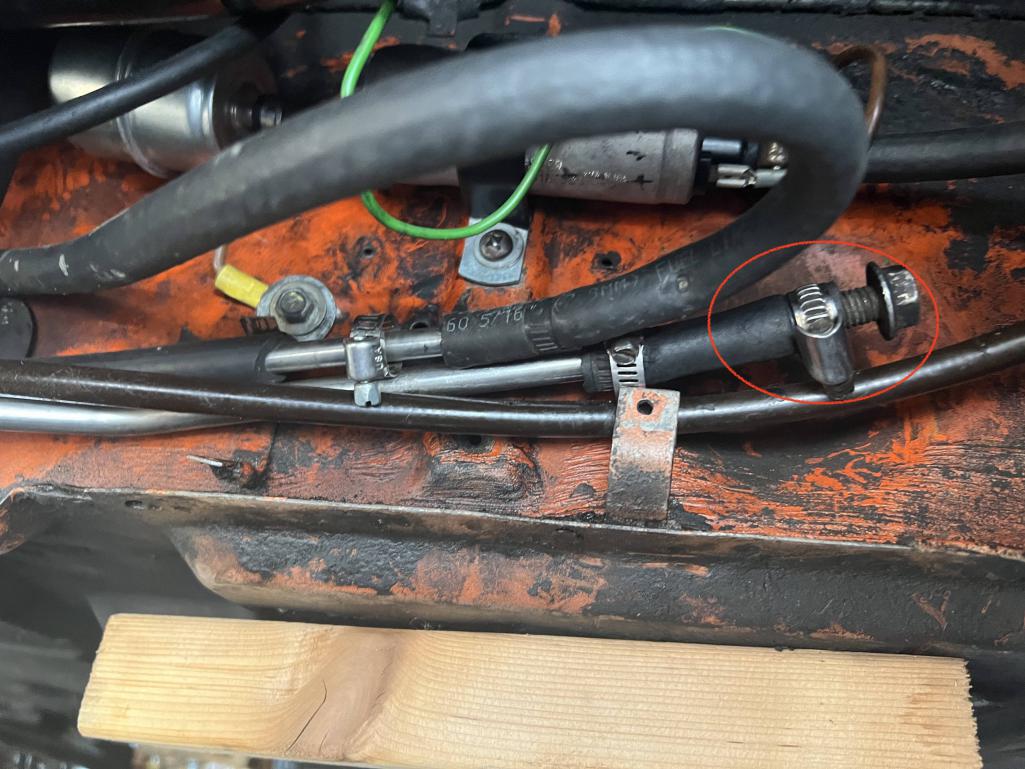|
|

|
Porsche, and the Porsche crest are registered trademarks of Dr. Ing. h.c. F. Porsche AG.
This site is not affiliated with Porsche in any way. Its only purpose is to provide an online forum for car enthusiasts. All other trademarks are property of their respective owners. |
|
|
| Peeterabytes |
 Oct 11 2023, 10:09 AM Oct 11 2023, 10:09 AM
Post
#1
|
|
Newbie  Group: Members Posts: 15 Joined: 4-August 23 From: DFW Member No.: 27,500 Region Association: None |
When my father back in the 1990s originally did the fuel pump placement to the rear and switch to a 2 port pump, had capped the return fuel line as shown in the photo. There was no connection coming from anywhere back to the return line.
 I am in the process of replacing out the fuel pump (again). So is the return line even needed? Mine could be different because it currently has Weber 40 IDAs on it. Prior to when I had to garage it in 1998 (blown piston ring), it ran for years and years with no return line fuel. So thinking it's a nice to have or mostly for DFI but not required for carbs? Maybe other Weber owners have a picture of where they are returning fuel from for a hint? Thanks! Peter |
  |
Replies
| Dave_Darling |
 Oct 11 2023, 12:37 PM Oct 11 2023, 12:37 PM
Post
#2
|
|
914 Idiot                Group: Members Posts: 15,051 Joined: 9-January 03 From: Silicon Valley / Kailua-Kona Member No.: 121 Region Association: Northern California 
|
With the original fuel-injection setup, the pump provides much more fuel than is needed. Excess comes out of the fuel pressure regulator and goes back to the tank. In 70-74 cars, the "R" port from the fuel pump hooks into that return path to deal with cases where the pump gets wildly over-pressure. The pressure regulator works by stopping flow until the fuel "upstream" of it is at the correct pressure, then letting the excess bleed off back to the tank.
The most common fuel pump and regulator setup for carbs supplies the fuel and the circuit stops at the carbs. No fuel returns to the tank. That's what you have. It is possible to swap out the fuel pressure regulator setup for one that bleeds excess fuel back to the tank, like the stock one does. It will help keep the fuel and pump a little cooler, as fresh fuel will always be circulating through it. Generally not regarded as necessary for a carbed setup. --DD |
| Peeterabytes |
 Oct 11 2023, 02:20 PM Oct 11 2023, 02:20 PM
Post
#3
|
|
Newbie  Group: Members Posts: 15 Joined: 4-August 23 From: DFW Member No.: 27,500 Region Association: None |
With the original fuel-injection setup, the pump provides much more fuel than is needed. Excess comes out of the fuel pressure regulator and goes back to the tank. In 70-74 cars, the "R" port from the fuel pump hooks into that return path to deal with cases where the pump gets wildly over-pressure. The pressure regulator works by stopping flow until the fuel "upstream" of it is at the correct pressure, then letting the excess bleed off back to the tank. The most common fuel pump and regulator setup for carbs supplies the fuel and the circuit stops at the carbs. No fuel returns to the tank. That's what you have. It is possible to swap out the fuel pressure regulator setup for one that bleeds excess fuel back to the tank, like the stock one does. It will help keep the fuel and pump a little cooler, as fresh fuel will always be circulating through it. Generally not regarded as necessary for a carbed setup. --DD BOOM! Thank you! (IMG:style_emoticons/default/beerchug.gif) |
Posts in this topic
  |
1 User(s) are reading this topic (1 Guests and 0 Anonymous Users)
0 Members:

|
Lo-Fi Version | Time is now: 31st October 2024 - 08:22 PM |
Invision Power Board
v9.1.4 © 2024 IPS, Inc.










